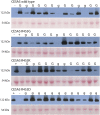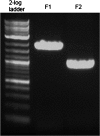A complementation assay for in vivo protein structure/function analysis in Physcomitrella patens (Funariaceae)
- PMID: 26191463
- PMCID: PMC4504723
- DOI: 10.3732/apps.1500023
A complementation assay for in vivo protein structure/function analysis in Physcomitrella patens (Funariaceae)
Abstract
Premise of the study: A method for rapid in vivo functional analysis of engineered proteins was developed using Physcomitrella patens.
Methods and results: A complementation assay was designed for testing structure/function relationships in cellulose synthase (CESA) proteins. The components of the assay include (1) construction of test vectors that drive expression of epitope-tagged PpCESA5 carrying engineered mutations, (2) transformation of a ppcesa5 knockout line that fails to produce gametophores with test and control vectors, (3) scoring the stable transformants for gametophore production, (4) statistical analysis comparing complementation rates for test vectors to positive and negative control vectors, and (5) analysis of transgenic protein expression by Western blotting. The assay distinguished mutations that generate fully functional, nonfunctional, and partially functional proteins.
Conclusions: Compared with existing methods for in vivo testing of protein function, this complementation assay provides a rapid method for investigating protein structure/function relationships in plants.
Keywords: Physcomitrella patens; cellulose synthase; complementation assay; gametophore development; protein structure/function relationships.
Figures





References
-
- Bibeau J. P., Vidali L. 2014. Morphological analysis of cell growth mutants in Physcomitrella. Methods in Molecular Biology 1080: 201–213. - PubMed
-
- Bischoff V., Desprez T., Mouille G., Vernhettes S., Gonneau M., Hofte H. 2011. Phytochrome regulation of cellulose synthesis in Arabidopsis. Current Biology 21: 1822–1827. - PubMed
-
- Bravo-Garcia A., Yasumura Y., Langdale J. A. 2009. Specialization of the Golden2-like regulatory pathway during land plant evolution. New Phytologist 183: 133–141. - PubMed
LinkOut - more resources
Full Text Sources
Other Literature Sources
Research Materials

